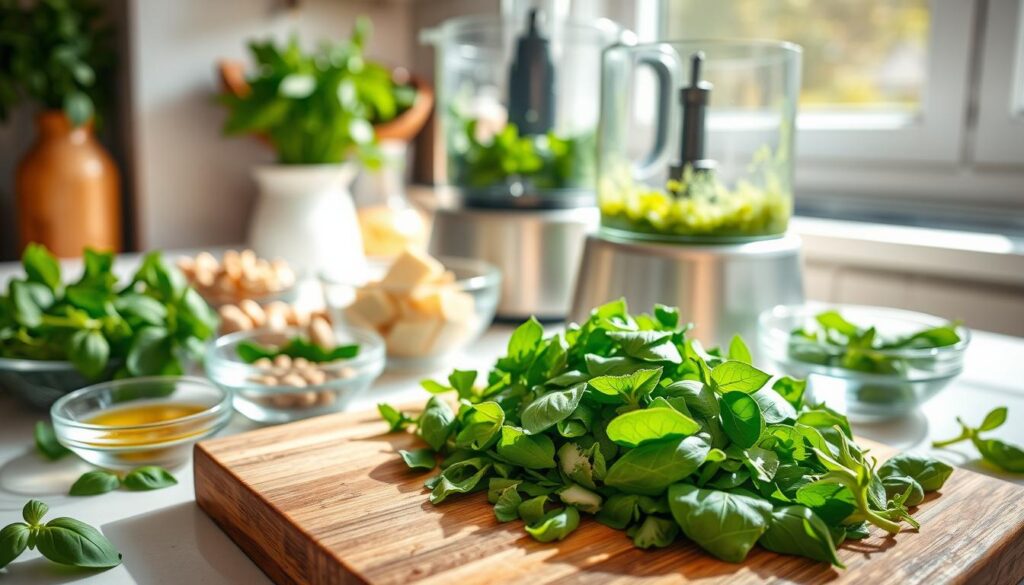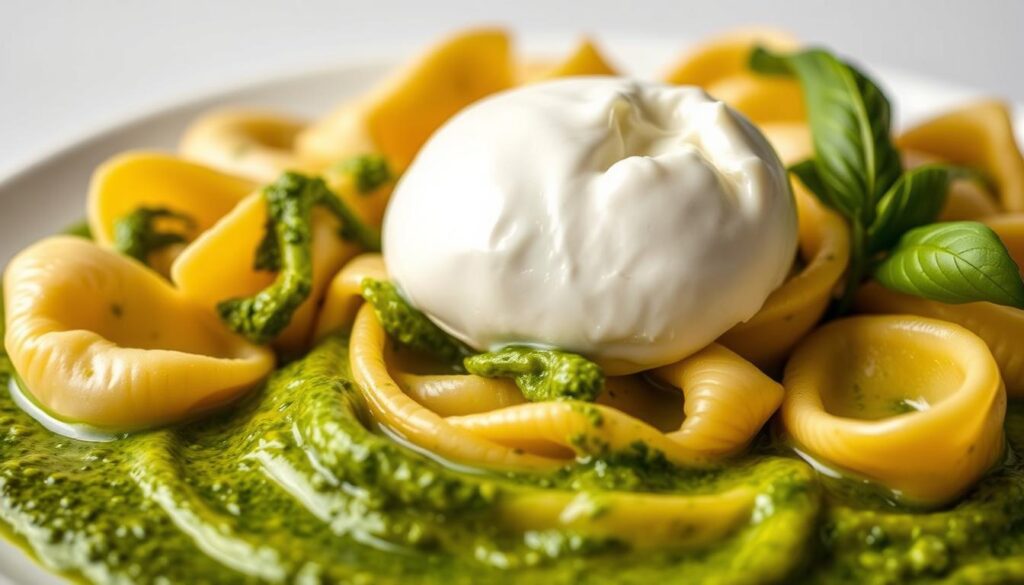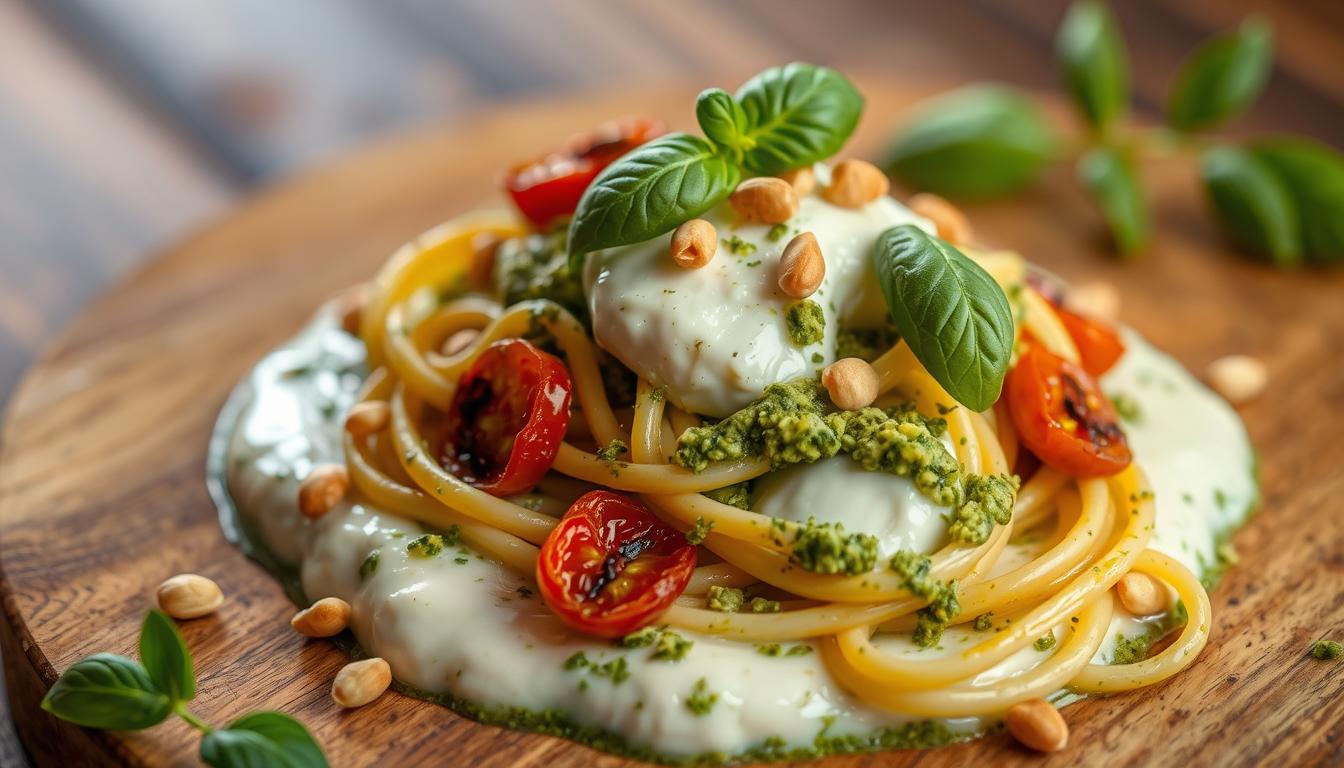I love food, and I’ve found something special. The creamy pesto tortellino burrata is a top Italian dish. It’s a mix of comfort and class in every bite.
Picture yourself in a warm Italian kitchen. Here, old flavors meet in a beautiful way. This dish combines cheese-filled tortellini, pesto, and creamy burrata. It’s a feast for your taste buds.
Every bite is a story of skill and tradition. Italian pasta dishes are more than food. They’re about love, connection, and enjoying great meals together.
Key Takeaways
- Discover the ultimate fusion of traditional Italian ingredients
- Experience a gourmet pasta dish that balances rich flavors
- Learn about the cultural significance of tortellini and burrata
- Explore a recipe that transforms simple ingredients into an extraordinary meal
- Understand the art of combining textures in Italian cuisine
Introduction to Italian Pasta Excellence
Explore the world of authentic Italian cuisine, where tortellini pasta is a key part. It’s a journey through regional flavors, new techniques, and cultural heritage. This pasta is a symbol of Italy’s rich history and passion for food.
History of Tortellini in Italian Cuisine
Tortellini pasta comes from the Emilia-Romagna region. It’s a story of skill and tradition. In Bologna, chefs made each piece by hand, keeping the pasta a favorite in Italy.
- Birthplace: Emilia-Romagna region of Italy
- Traditional preparation: Handmade with precision
- Cultural significance: Symbol of regional culinary expertise
The Rise of Burrata in Modern Dishes
Creamy burrata cheese has changed Italian food, becoming a key ingredient. Made from mozzarella and cream, it adds a smooth texture to dishes. This cheese makes simple recipes taste like gourmet meals.
| Cheese Characteristic | Description |
|---|---|
| Origin | Puglia, Southern Italy |
| Texture | Soft, creamy interior |
| Culinary Use | Appetizers, pasta dishes, salads |
Understanding Pesto’s Cultural Significance
Basil pesto sauce is at the heart of Italian cooking. From Genoa, it’s a mix of basil, garlic, pine nuts, Parmesan, and olive oil. It’s more than a sauce; it shows the beauty of Italian simplicity and skill.
“Pesto is not just a sauce, it’s a celebration of fresh ingredients and generations of culinary wisdom.” – Italian Culinary Expert
Essential Ingredients for Creamy Pesto Tortellino Burrata
To make the perfect creamy pesto tortellino burrata, you need top-notch ingredients. These ingredients should work well together. Start by learning what makes this dish special.
Begin with premium cheese tortellini. Choose fresh tortellini filled with rich cheese. This cheese should match the vibrant pesto sauce.
- Cheese tortellini (12 oz)
- Fresh burrata cheese (2 balls)
- Basil pesto sauce
- Extra virgin olive oil (5-8 tablespoons)
- Fresh basil leaves
- Pine nuts (optional)
The key to this dish is its pesto ingredients. A classic basil pesto needs fresh basil, good olive oil, garlic, pine nuts, and parmesan cheese. These ingredients will make your burrata appetizer amazing.
“Great cooking is about ingredients and how you combine them.” – Wolfgang Puck
When picking burrata, choose fresh, creamy cheese. It should be soft and have a milky flavor. This flavor will boost your pesto tortellini.
Nutritional highlights show the dish’s balance:
- Total calories per serving: 822 kcal
- Protein per serving: 11g (22% daily value)
- Calcium: 239mg (24% daily value)
The Art of Selecting Quality Burrata Cheese
Finding the perfect creamy burrata cheese can make your dishes stand out. It’s all about knowing what to look for in quality burrata.
When looking for top-notch burrata, pay attention to a few important things. The texture and how fresh it is will make a big difference in your dish.
Fresh vs Aged Burrata: Understanding the Differences
Fresh burrata is known for its:
- Soft, pillowy exterior
- Creamy, rich interior
- Mild, delicate flavor
- Smooth, moist look
Storage and Temperature Guidelines
Storing burrata right is key to keeping it fresh. Here are some tips:
- Keep it at room temperature before serving
- Use it within 24 hours of opening
- Refrigerate when not in use
- Let it sit at room temperature for 30 minutes before serving
Identifying Premium Burrata Quality
Experts say to look for these signs of high-quality burrata:
- Appearance: A smooth, white surface with no flaws
- Texture: It should feel soft and delicate
- Smell: It should have a fresh, milky scent
- Touch: It should feel light and soft
“Great burrata tells a story of craftsmanship and passion” – Italian Cheese Master
Learning how to pick the best burrata will make your dishes unforgettable. It’s all about choosing the right cheese for your recipes.
Making the Perfect Basil Pesto Sauce
Making basil pesto sauce is like creating a work of art. It turns simple ingredients into a vibrant dish. Your basil pesto sauce will be the heart of your tortellini, adding intense flavor to every bite.

For a traditional basil pesto sauce, choose the best ingredients. Here’s what you need for an amazing pesto:
- Fresh basil leaves (1 cup)
- Extra-virgin olive oil (⅓ cup)
- Toasted pine nuts (½ cup)
- Finely grated Parmesan cheese (⅓ cup)
- Garlic cloves (2)
- Kosher salt (¼ teaspoon)
- Lemon juice (1½ tablespoons)
Making your basil pesto sauce takes about 10 minutes. The way you make it is just as important as the ingredients. This classic sauce is perfect for your basil pesto pasta.
| Ingredient | Quantity | Nutritional Value |
|---|---|---|
| Basil Leaves | 1 cup | Rich in Vitamin K |
| Pine Nuts | ½ cup | 14g Healthy Fats |
| Olive Oil | ⅓ cup | Monounsaturated Fats |
Want to try something different? You can swap pine nuts for walnuts or use hemp seeds. Just make sure the flavor still goes well with your tortellini.
Pro tip: For a thinner sauce, add up to 2 tablespoons more olive oil. You can keep your pesto in the fridge for 2 weeks or freeze it for 6 months. This way, you’ll always have it ready.
Step-by-Step Tortellini Preparation Techniques
Learning to cook tortellini pasta is all about precision and care. It doesn’t matter if you’re using homemade or store-bought pasta. Knowing the right techniques can make your dish stand out.
Preparing tortellini is more than just boiling water. Each step is important to make a dish that will impress your taste buds.
Cooking Time and Temperature Control
Timing is everything when cooking tortellini. Here are some key tips:
- Use a 4-quart pot for optimal cooking space
- Bring water to a rolling boil
- Add a pinch of salt to enhance flavor
- Cook fresh tortellini for 2-3 minutes
- Cook frozen tortellini for 3-5 minutes
Al Dente Perfection Tips
To get the perfect al dente texture, pay close attention:
- Watch for tortellini to float to the surface
- Test for firmness by tasting a piece
- Drain immediately when texture is right
- Avoid overcooking to prevent mushiness
Preventing Tortellini from Sticking
“The secret to perfect tortellini is in the preparation.” – Italian Cooking Master
To stop your tortellini fillings from sticking together:
- Add a small amount of olive oil to boiling water
- Stir gently immediately after adding tortellini
- Use a large pot to give pasta room to move
- Rinse with cold water after cooking if needed
By following these steps, you’ll make tortellini that rivals restaurant quality. It’s a great way to show off handmade pasta and tasty fillings.
Combining the Elements: Creating Creamy Pesto Tortellino Burrata

Making creamy pesto tortellino burrata is all about precision and passion. Start by cooking your tortellini until they’re just right, al dente in 8-10 minutes. The key to a great creamy pasta sauce is finding the right mix of ingredients.
To make your tortellini al pesto, follow these steps:
- Cook tortellini until perfectly tender
- Reserve 1/4 cup of pasta water for sauce consistency
- Gently toss tortellini with fresh basil pesto
- Add a splash of reserved pasta water to create creamy texture
Then, add fresh burrata. Tear it into big pieces and put them on top of the warm tortellini. The heat will melt the cheese a bit, making it creamy and luxurious.
To add a fancy touch, top it with fresh basil leaves and a drizzle of good olive oil. Your creamy pesto tortellino burrata is now ready to wow pasta lovers.
Pro tip: Serve immediately to enjoy the optimal blend of warm pasta and creamy burrata.
Garnishing and Presentation Strategies
Creating a stunning burrata appetizer is more than just cooking. The way you present it can make your dish stand out. Your goal is to create a dish that looks and tastes amazing.
When making your creamy pesto tortellino burrata, use these garnishing tips to improve it:
Fresh Herb Selection
- Freshly chopped basil leaves for vibrant color
- Delicate sprigs of parsley for a touch of green
- Microgreens for sophisticated texture
- Chiffonade-cut herbs for elegant presentation
Plating Techniques for Visual Appeal
Professional chefs see presentation as an art. Here are some ways to make your burrata appetizer look stunning:
- Create height by stacking tortellini
- Use white plates to make colors pop
- Drizzle high-quality olive oil in artistic patterns
- Scatter toasted pine nuts for textural contrast
| Garnish | Visual Impact | Flavor Enhancement |
|---|---|---|
| Fresh Basil Leaves | Bright Green Color | Aromatic Freshness |
| Toasted Pine Nuts | Textural Contrast | Nutty Undertones |
| Olive Oil Drizzle | Glossy Sheen | Rich Flavor Depth |
Pro tip: Serve your gourmet pasta dishes immediately after plating to maintain the perfect temperature and visual appeal.
Wine Pairing and Serving Suggestions
Make your gourmet pasta dishes even better with the right wine. The perfect wine can turn your creamy pesto tortellino burrata into a memorable meal.
Here are some top picks for wine pairings with this tasty Italian dish:
- White Wine Options:
- Pinot Grigio – Light and crisp
- Sauvignon Blanc – Refreshing with herbal notes
- Vermentino – Bright and acidic
- Red Wine Options:
- Light-bodied Sangiovese – Complements without overpowering
- Dolcetto – Soft tannins perfect for creamy dishes
The goal is to find a wine that matches the creamy pesto and soft burrata.
| Wine Type | Flavor Profile | Recommended Pairing |
|---|---|---|
| Pinot Grigio | Light, Crisp | Ideal for creamy pesto dishes |
| Sauvignon Blanc | Herbal, Bright | Complements basil pesto notes |
| Sangiovese | Light, Fruity | Balanced with burrata richness |
Pro tip: Chill your wine a bit before serving. It makes the meal even more enjoyable and brings out the dish’s flavors.
Tips for Storage and Reheating
Keeping your creamy pasta sauces fresh is key. Your leftover tortellini pasta needs special care to keep its taste and texture just right.
Refrigeration Best Practices
Here’s how to store your tortellini pasta:
- Put the dish in an airtight container
- Chill it within 2 hours of cooking
- It’s good for up to 3 days
- Keep it sealed to avoid moisture loss
Reheating Techniques
To warm up your tortellini pasta, handle it gently:
- Take it out of the fridge 10-15 minutes before heating
- Use low heat to avoid overcooking
- Add a bit of milk or water to keep the sauce smooth
- Stir slowly to heat it evenly
Freezing Recommendations
Freezing is a great way to keep tortellini pasta longer. Just freeze it without the burrata cheese. It can stay frozen for up to 1 month in a freezer-safe container.
Pro tip: Always reheat tortellini pasta slowly to maintain its creamy sauce and prevent pasta from becoming tough or dry.
Conclusion
Your journey through gourmet pasta dishes ends with this creamy pesto tortellino burrata recipe. Italian cuisine is known for its simple yet sophisticated flavors. This dish shows the perfect mix of both.
Choosing the right ingredients and following traditional methods are key. Your dedication to quality turns a simple meal into a special experience. Each part of the dish brings a taste of Italy to your plate.
As you keep trying this recipe, remember that cooking is a way to express yourself. Traditional methods are a base, but your creativity can make it even better. Enjoy cooking, share your dishes, and celebrate Italian traditions through food.
This gourmet pasta dish is perfect for anyone who loves to cook. It brings a bit of Italy to your home. Let your passion for cooking shine, and savor every delicious moment.
FAQ
What is the origin of tortellini?
Tortellini come from Italy, especially around Bologna and Modena. They are small, ring-shaped pasta. They are filled with meat, cheese, or veggies, showing Italy’s rich food culture.
How do I choose the best burrata for this dish?
Choose fresh burrata with a creamy center and soft shell. Buy it from a good cheese shop or Italian store. It should smell milky and feel heavy and soft.
Can I make pesto if I don’t have a traditional mortar and pestle?
Yes, you can make pesto without a mortar and pestle. Use a food processor or blender. Just pulse the ingredients gently to keep the sauce smooth and flavorful.
How long can I store leftover creamy pesto tortellini?
Keep it in an airtight container in the fridge for 1-2 days. Keep the burrata separate and add it fresh when reheating. Warm the pasta gently to keep it creamy.
What wine pairs best with creamy pesto tortellino burrata?
Pinot Grigio or Vermentino are great choices. These wines are light and refreshing. They complement the creamy burrata and pesto without overpowering the tortellini.
Is this dish vegetarian?
It can be vegetarian if you use cheese-filled tortellini. Make sure your pesto doesn’t have Parmigiano-Reggiano to keep it vegetarian.
Can I make this dish gluten-free?
Yes, use gluten-free tortellini made from rice, corn, or chickpea. Make sure the pesto is also gluten-free.
How can I enhance the flavor of my pesto?
Try adding toasted pine nuts, lemon zest, or different herbs. Use high-quality olive oil and fresh basil to improve the flavor.
What’s the ideal serving temperature for this dish?
Serve it right after making it. The tortellini should be hot, the pesto at room temperature, and the burrata slightly chilled. This mix of temperatures makes each bite special.
Are there any common mistakes to avoid when preparing this dish?
Avoid overcooking the tortellini and using low-quality ingredients. Don’t add burrata too early. Cook pasta al dente, use fresh ingredients, and add burrata just before serving.

